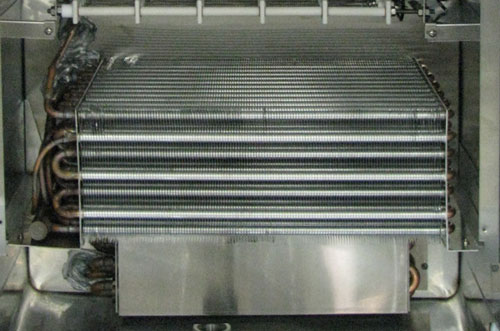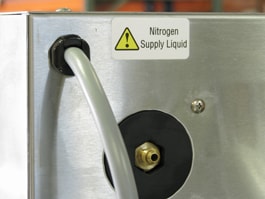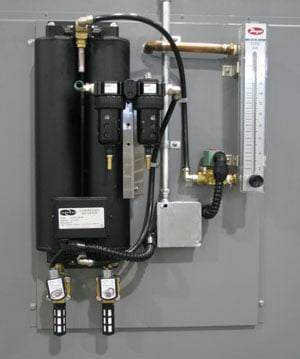Humidity test chambers usually employ one of three dehumidification techniques to achieve lower humidity conditions. These methods may be used in temperature-only applications, as well, when risk of condensation is high due to massive test loads and/or very fast temperature cycling rates.
 1. Refrigeration coil: Nearly every humidity chamber should have refrigeration to ensure humidity control. To start with, relative humidity varies with temperature, so a stable temperature is required. Most humidity chambers have a separate dehumidification coil to attract moisture. It is set-up to stay above freezing to avoid becoming covered with ice. The main cooling coil is also kept above freezing, as well.
1. Refrigeration coil: Nearly every humidity chamber should have refrigeration to ensure humidity control. To start with, relative humidity varies with temperature, so a stable temperature is required. Most humidity chambers have a separate dehumidification coil to attract moisture. It is set-up to stay above freezing to avoid becoming covered with ice. The main cooling coil is also kept above freezing, as well.
 2. Nitrogen purge: Nitrogen gas is very dry. By slowly bleeding nitrogen gas into the chamber, moisture-laden air is purged out of the chamber.
2. Nitrogen purge: Nitrogen gas is very dry. By slowly bleeding nitrogen gas into the chamber, moisture-laden air is purged out of the chamber.
 3. Dry-air purge: Because nitrogen isn't always readily available, a dry-air system is more common. External compressed air is fed into a desiccant dryer system before being used to purge the chamber air. (A desiccant is a substance that easily absorbs moisture, like the silica gel crystal packets you find packaged with some products.) The dry-air purge system doesn't need much maintenance. The system uses two desiccant “towers”. One is being used to dry the compressed air while the other tower is dried out (and the moisture vented to the room). You will often hear these systems “pop” while switching between towers. The desiccant can be used for years before replacement desiccant is needed.
3. Dry-air purge: Because nitrogen isn't always readily available, a dry-air system is more common. External compressed air is fed into a desiccant dryer system before being used to purge the chamber air. (A desiccant is a substance that easily absorbs moisture, like the silica gel crystal packets you find packaged with some products.) The dry-air purge system doesn't need much maintenance. The system uses two desiccant “towers”. One is being used to dry the compressed air while the other tower is dried out (and the moisture vented to the room). You will often hear these systems “pop” while switching between towers. The desiccant can be used for years before replacement desiccant is needed.






